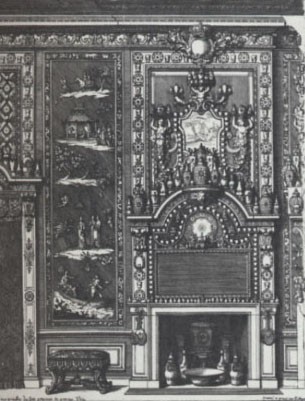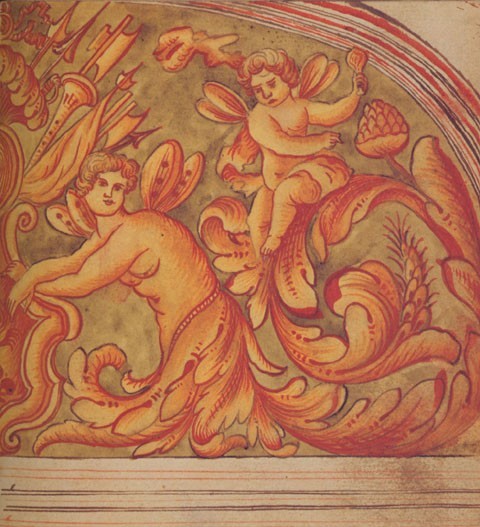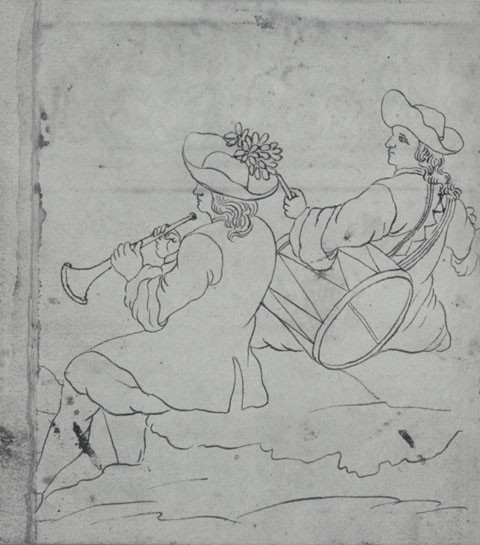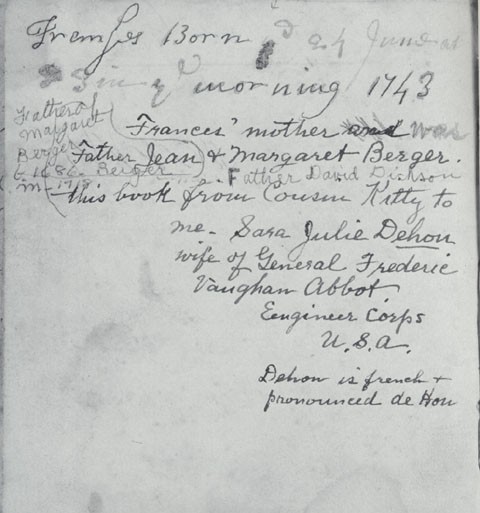
Detail of A New Plan of ye Great Town of BOSTON in New England in AMERICA With the many Additional Buildings &. New Streets to the Year 1733. Etching and engraving. 16 13/16" x 23". Originally drawn by John Bonner and engraved by Francis Deming, this map was revised by William Price and Thomas Johnston in 1733. Berger’s residence was beneath Coal’s Garden on the northwest corner of Pond and Short streets and the Huguenot Church (marked K) on School Street. (Courtesy of The John Carter Brown Library at Brown University)

Lady with Jewels, inscribed “J. Cooper 1714,” possibly Boston. Oil on canvas. 14" x 12". (Courtesy, Peabody Essex Museum.)

Designs for birds and insects illustrated on pl. 11 of John Stalker and George Parker’s, A Treatise of Japanning and Varnishing (Oxford, 1688). (Courtesy, Winterthur Library: Printed Books and Periodical Collection.)

Designs “For Drawers for Cabbinets to be Placed according to yor. fancy” illustrated on pl. 18 of John Stalker and George Parker’s, A Treatise of Japanning and Varnishing (Oxford, 1688). (Courtesy, Winterthur Library.)

Design for a chimney wall with lacquered panels and porcelain in Daniel Marot’s, Nouvelle chemenées faittes en plusieurs en droits de la Hollande et autres provinces, Netherlands, ca. 1700. Etching and engraving. Like many of his contemporaries, Marot combined Oriental motifs with European baroque designs. (Courtesy, Cooper-Hewitt, National Design Museum, Smithsonian Institution. acc. 1988–4–48.)

Ceiling design illustrated in Jean Cotelle's Livres des Ornemens pour Plafonds (Paris, ca. 1640).(Courtesy, Ashmolean Museum.)

Jean Berger’s Design Book: Huguenot Tradesmen and the Dissemination of French Baroque Style

Jean Berger’s Design Book: Huguenot Tradesmen and the Dissemination of French Baroque Style

Jean Berger’s Design Book: Huguenot Tradesmen and the Dissemination of French Baroque Style

Jean Berger’s Design Book: Huguenot Tradesmen and the Dissemination of French Baroque Style

Jean Berger’s Design Book: Huguenot Tradesmen and the Dissemination of French Baroque Style

Jean Berger’s Design Book: Huguenot Tradesmen and the Dissemination of French Baroque Style

Jean Berger’s Design Book: Huguenot Tradesmen and the Dissemination of French Baroque Style

Jean Berger’s Design Book: Huguenot Tradesmen and the Dissemination of French Baroque Style

Jean Berger’s Design Book: Huguenot Tradesmen and the Dissemination of French Baroque Style

Jean Berger’s Design Book: Huguenot Tradesmen and the Dissemination of French Baroque Style

Jean Berger’s Design Book: Huguenot Tradesmen and the Dissemination of French Baroque Style

Jean Berger’s Design Book: Huguenot Tradesmen and the Dissemination of French Baroque Style

Jean Berger’s Design Book: Huguenot Tradesmen and the Dissemination of French Baroque Style

Jean Berger’s Design Book: Huguenot Tradesmen and the Dissemination of French Baroque Style

Jean Berger’s Design Book: Huguenot Tradesmen and the Dissemination of French Baroque Style

Jean Berger’s Design Book: Huguenot Tradesmen and the Dissemination of French Baroque Style

Jean Berger’s Design Book: Huguenot Tradesmen and the Dissemination of French Baroque Style

Jean Berger’s Design Book: Huguenot Tradesmen and the Dissemination of French Baroque Style
Art and furniture historians traditionally have focused on the role of Huguenot-born court artisans, such as Daniel Marot (1663–1752), as the primary disseminators of French baroque style. But nearly a quarter million Protestants fled France after Louis XIV’s revocation of the Edict of Nantes in 1685, and many of these refugees also were highly skilled tradesmen familiar with the court style that emanated from Versailles during Louis XIV’s reign. Highly conversant in the baroque decorative vocabulary, such men were, because of their relocation, collectively more responsible than court artisans for the diffusion of French baroque style. The recently discovered design book of Jean Berger (fl. ca. 1718–1732), a Boston Huguenot painter-stainer, presents new evidence for the influence of Huguenot tradesmen among the middle classes in both Europe and colonial America.[1]
The painter-stainers of Berger’s time were versatile artisans whose skills included ornamental painting, graining, marbleizing, gilding, japanning, and varnishing. The full extent of Berger’s work may never be determined, but presumably he decorated buildings, ships, carriages, furniture, and a broad range of household objects.
Jean Berger probably was a member of the Berger (Bergier, Barger, Bargier) family that settled in Boston about 1685. The progenitor of this family, known only as “M. le Sr. Berger,” was a merchant from La Rochelle who enjoyed the patronage of Jean Baptiste Colbert (1619–1683), France’s minister of finance prior to the edict’s revocation. Appointed as the king’s lieutenant for the French colony of Acadia (now Nova Scotia) in 1684, Berger earned the ire of Quebec’s Catholic hierarchy, who opposed placing “a most obstinate Huguenot” so close to the Protestant English colonies. In 1685, a group of Huguenots who arrived in Boston from La Rochelle via Casco, Maine, included one Philip Barger. Barger was subsequently a mariner and part owner of the brigantine, Neptune, which engaged in Boston’s Carribean trade. At his death in 1703, Philip was survived by his widow Margaret and three children: Elizabeth (b. 1686), John (1688–1708), and Philip (1690–1721).[2] Owing to the scarcity of records for Boston Huguenots, the precise relationship between the Philip Barger family and Jean Berger remains unclear.
The design book and a few court cases involving Berger represent virtually everything known about his life and work. Written in both English and French, a sketchy family register at the back of the book records the birth of Berger’s wife, Rachel, on October 16, 1686, and the death of his father-in-law on June 29, 1730. It also reveals that Berger had at least four children and was a member of Boston’s sizable Huguenot community.[3] His approximate working dates can be extrapolated from the date 1718 on the frontis of the book, Berger’s last known court appearance in 1732, and Rachel’s appearance in court as a widow in 1736. Court records also indicate that Berger rented a house on the northwest corner of Pond and Short streets from Mary White, and that he leased a portion of the house to bookbinder Joseph Wheeler (fig. 1).
Ironically, the most important information regarding Jean Berger’s career comes from the circumstances surrounding a personal tragedy. On December 17, 1719, a Frenchman named John Harristy attacked Berger along the docks of Boston harbor. Berger subsequently sued, charging Harristy “with force & Arms an Assault did make & him did beat, wound, & evilly intreat so that of his life it was dispaired.” The court convicted Harristy and ordered him to pay damages totaling £19.3 plus Berger’s court costs. The defendant then appealed his conviction.[4]
The evidence presented in Harristy’s appeal provides a picture of the tradesmen among whom Berger lived and worked. Witnesses summoned to testify included physician Laurence Delhonde, merchant Temple Nelson, pewterer Thomas Smith (1678–1742), and “Felix Powell, who lives with Cooper the Painter.” Powell’s deposition described the assault:
Felix Powell, Aged about 21 years upon his Oath being Sworne declares that Last Thursday Evening being ordered by his Master John Cooper painter to attend John Bergie, a French Painter about a peice of Painting work on board a Vessell at the Dock, but going on board met the said Bergie come from said Vessell with his Box of Paint and Brushes and he told me he would not work any Longer that night, at which time John Harristy a French man being the Same Person now present as a Defendant came up with him the said Bergie and Spoke to Each other in French, which the Deponant did not understand, and immediately the said Harristy fell upon the said Berger and struck him Severell Blows with a Stick he then had in his hand, and then in English threatened him that he would be up with him. The Plaintiff, after the Defendant had struck him, bid me take notice how he had abused him and so they parted.[5]
Delhonde stated that he had treated Berger’s head wounds twice daily for over a month, using “Lotens, Imbrocations, fomentations, Ointments & Plaisters,” and presented a list of medical expenses totaling £5.16.6. The court upheld Harristy’s conviction, fined him an additional 20s. for the government, and released him on recognizance for good behavior for a period of one year. Rigger John Jarrard and chairmaker Samuel Mattocks, Jr., (b. 1678) provided sureties for Harristy in the amount of £25 each during the probationary period.[6]
Powell’s master probably was New England artist J. Cooper, whom art historians have speculated was English-born artist John Cooper (ca. 1695–1754), son of London art dealer and print publisher Edward Cooper (ca. 1660–1725). Many of his paintings are signed “J. Cooper” or initialed and dated between 1714 and 1718 (fig. 2). Assuming these two painters are the same man, Berger’s suit provides the first documentary evidence of John Cooper’s presence in the colonies from 1718 to 1721.[7]
As a French-speaking artisan in a primarily English-speaking community, Berger possibly had difficulty securing private patronage. Powell’s deposition and suits involving Berger, Cooper, and other Boston tradesmen suggest that he frequently worked as a subcontractor. In 1721, Berger sued Cooper and his partner, apothecary Thomas Creese, Jr., for failing to honor a £5 note. The court ruled against Cooper and Creese and ordered them to pay the balance due on the note, plus Berger’s legal expenses. Berger initiated another suit against Cooper later that year, but the artist failed to appear before the court. This court record is the last reference to Cooper in Boston, and it coincides with the career of the English-born artist who assumed his father’s print-selling business in London around 1725.[8]
Creese’s brother-in-law was William Price (d. 1771), a prominent Boston cabinetmaker, art dealer, and print publisher. Price advertised that he sold a variety of London-made prints and maps, oil paintings in carved and gilt frames, varnish, and “Jappan Work, viz. Chest of Drawers, Corner Cupboards, Large & Small Tea Tables, &c. done after the best manner by one late from London.” Price in turn maintained a close business relationship with Thomas Johnston (1707–1767), who, in 1732, had trade cards advertising “Japaning, Gilding, Painting, Varnishing” at his shop on Ann Street.[9]
The chinoiserie drawings in Berger’s design book identify him as one of Boston’s earliest japanners, along with Nehemiah Partridge (d. ca. 1726) and Joshua Roberts (d. 1719). Furniture historians have identified two distinct schools of early Boston japanning. One includes tradesman Robert Davis (d. 1739) and his son-in-law, William Randle. Their work consists of large and loosely arranged chinoiserie motifs painted against a black ground with little attention to their relationship in any greater design. The other school centers around Thomas Johnston, Thomas Johnston, Jr. (1731–ca. 1776), and Daniel Rea (active 1767–1800), who had a “more integrated and ornate style.” Their work typically features elaborately drawn chinoiserie scenes on both black and tortoiseshell backgrounds and baroque elements, such as winged cherubs’ heads, fluted columns, and floral designs. Stylistically, Berger’s drawings are closer to the japanning attributed to Johnston and the tradesmen in his sphere.[10]
At first glance, the drawings in Berger’s book appear to be generally similar to those in John Stalker and George Parker’s Treatise of Japanning and Varnishing (1688) (figs. 3, 4) and Johan Nieuhof’s Atlas Chinensis (1665), two standard pattern books for late-seventeenth- and eighteenth-century chinoiserie designs. But not one image is a direct copy from either work. Berger’s designs are either original or borrowed from an unknown source, and they attest to the role of Huguenot artisans as transmitters of the fashion for chinoiserie. Marot used chinoiserie designs for porcelain rooms with lacquer paneling in two of his earliest commissions as a refugee—Binnenhof, The Hague (1685), and the castle at Honselaarsdijk (1686)—and later at Hampton Court and Kensington Palace (fig. 5).[11]
The watercolors and sketches on Berger’s first six pages are reminiscent of those by French artists, Jean Cotelle (1607–1676), Jean Le Pautre (1617–1682), Paul Androuet Ducerceau (ca. 1630–1713), and Jean Berain (1639–1711), whose designs for ornament were published in the late seventeenth century (fig. 6). Based on mythology and ancient Roman wall paintings, their work defined the taste for baroque decoration “a l’antique” and greatly influenced Marot and other Huguenot emigrés.[12] Berger’s first three drawings depict satyrs and nymphs in the French “arabesque” style, with Bacchic lions, cupids, and eagles amidst scrolling acanthus. Two of the drawings have cartouches with fleur-de-lis; one is supported by a heavily molded plinth dated 1718, and the other is surmounted by a shield with military trophies. Two intermediate pages present decorative borders with scrolling acanthus and lambrequin strapwork.
Painted decoration on buildings, ships, and furniture produced in early Boston was probably far more prevalent than the surviving evidence suggests. Until its destruction around 1833, the Clark-Frankland house (ca. 1715) had an ornate scheme:
The flutings and capitals of the pilasters, the dentils of the cornice, the vault and shelves of the buffet, were all heavily guilded. . . . The peculiar decoration consisted of a series of raised panels filling these compartments, reaching from the surbase to the frieze, eleven in all, each embellished with a romantic landscape painted in oil colors, the four panels opposite the windows being further enriched by the emblazoned escutcheons of the Clarks, the Saltonstalls, and other allied families. Beneath the surbase, the panels, as also those of the door, were covered with arabesques. The twelfth painting was a view of the house upon a horizontal panel over the mantel, and beneath this panel, inscribed in an oval, was the monogram of the builder, W. C. At the base of the gilded and fluted vault of the buffet was a painted dove.
Although only two landscape panels survive from the Clark-Frankland house, the interior of the Vernon house (ca. 1708) in Newport, Rhode Island, has several surviving japanned panels depicting Oriental figures and exotic birds and beasts.[13]
Finally, a closer look at the design book (fig. 7) speaks directly about the life and work of Jean Berger. The two fluted columns and triangular pediment on the frontis frame the words “Ses Jean Berger Qui A Fait Ses Ouvrage Dece Livrect A Baston Ce MDCCXVIII” (“It is Jean Berger who has done this work in this book in Boston 1718”). The iconography provides immediate clues. Atop the pediment are two figures that define his work as an ornamental painter in early America, a male holding the anchor of commerce and a female looking into the mirror of beauty. The English motto “Dieu est mon Droy” on a tapestry at the base of the columns proclaims Berger’s loyalty to his new sovereign, while the flaming heart pierced by two arrows between his initials in the center of the pediment serves as a reminder of Huguenot religious persecution.
Like Berger, thousands of Huguenot tradesmen fanned out across Europe and America seeking their religious freedom. In their wake, they spread knowledge of French taste and culture, greatly influencing their newfound communities. Jean Berger’s design book survives as a remarkable testament to the work of these largely forgotten and unknown craftsmen. But several important questions remain unanswered. Where was Berger born, and when did he die? Where was he trained? What design sources did he use? Who were the other artisans with whom he worked, and how did he impact them? Does any of Jean Berger’s work survive? The design book is presented here in its entirety for those interested in pursuing these questions.
ACKNOWLEDGMENTS
The author thanks Luke Beckerdite, Thomas Savage, and Robert Trent for helping prepare this manuscript and Rick Rhodes for his excellent photography of Jean Berger’s design book. I am especially grateful to Anne Rogers Haley whose research greatly illuminated Berger’s career.
For more on Marot and Huguenot court artisans, see Museum of London, The Quiet Conquest: The Huguenots 1685–1985 (London: by the museum, 1985); and Reinier Baarsen, Gervase Jackson-Stops, Phillip M. Johnston, and Elaine Evans Dee, Courts and Colonies; The William and Mary style in Holland, England and America (Seattle: University of Washington Press for the Cooper-Hewitt Museum and Carnegie Museum of Art, 1988). Thomas Savage and I discovered the design book while researching a group of objects associated with Charleston merchant Nathaniel Russell (1738–1820). The book descended for eight generations in the family of Russell’s son-in-law, Bishop Theodore Dehon (1776–1817). Berger was Dehon’s great grandfather. The book and other Dehon family artifacts are on loan to Nathaniel Russell House, Historic Charleston Foundation.
For more on the Berger family, see Charles W. Baird, History of the Huguenot Emigration to America, 2 vols. (Baltimore: Regional Publishing, 1966), 1:143–45 2:210. Massachusetts State Archives, Boston, Commercial Series 1685–1714, vol. 7, pp. 79, 104–5. A Report of the Record Commissioners Containing Boston Births, Baptisms, Marriages, and Deaths, 1630–1699 (Boston: Rockwell and Churchill City Printers, 1883), pp. 167, 178, 189.
Many of the names mentioned in this section are easily identifiable as members of Boston’s Huguenot community.“Mr. mersiee,” who baptized Berger’s first child, almost certainly is the Reverend Andrew Le Mercier (d. 1764), rector of Boston’s Huguenot church from 1715 until 1748. “Madame dupe,” named as the child’s godmother, probably is the wife of Jean Dupuis, or Dupee (d. 1734), an elder of the French church. “Mr. fransoy masc” probably refers to a member of the Mascarene family (Baird, Huguenot Emigration, 2:233, 239–45, 250–51). Berger’s daughter Margaret married David Dickson on September 31, 1736, and the couple had three children: Frances, David, and Joseph. In 1759, Frances Dickson (1743–1804) married Huguenot perukemaker Theodore Dehon (d. 1796) (Christopher E. Gadsden, An Essay on the Life of the Right Reverend Theodore Dehon, D.D. [Charleston, S. C., 1833], pp. 41–44). Elizabeth Given vs. Rachel Berger, August 5, 1732, Suffolk County Supreme Judicial Court (hereinafter SCSJC), Index to Suffolk Files, 1629–1795, no. 32696, Massachusetts State Archives, Boston. Rachel Berger, March 26, 1736, scsjc, no. 166715. Mary White vs. Jean Berger, November 24, 1726, scsjc, no. 18926. Jean Berger vs. Joseph Wheeler, January 24, 1728, scsjc, no. Z1296.
Jean Berger vs. John Harristy, undated, Suffolk County Court of Common Pleas (hereinafter SCCCP), Records Book, 1715–1721, p. 11, Massachusetts State Archives, Boston.
The witnesses are listed in Jean Berger vs. John Harristy, January 7, 1719/20, SCSJC, no. 163519. Powell’s deposition is in Jean Berger vs. John Harristy, undated, scsjc, no. 26989.
Jean Berger vs. John Harristy, March 15, 1720, SCSJC, no. 14839. Jean Berger vs. John Harristy, January 5, 1719/20, SCSJC, no. 13803.
Examples of J. Cooper’s work are at the Yale University Art Gallery, the Winterthur Museum, the Peabody Essex Museum, the New York Historical Society, the Connecticut Historical Society, and the Wadsworth Athenaeum. For more on Cooper, see George C. Groce, “Who Was J(ohn?) Cooper (b. ca. 1695 – living 1754),” The Art Quarterly 18, no. 1 (Spring 1955): 73–82; James Thomas Flexner, First Flowers of Our Wilderness (New York: Dover, 1947), pp. 45–46; and Waldron Phoenix Belknap, American Colonial Painting (Cambridge, Mass.: Harvard University Press, 1959), pp. 223–25, 319–20.
Jean Berger vs. John Cooper and Thomas Creese, Jr., undated, SCCCP, p. 13. Jean Berger vs. John Cooper and Thomas Creese, Jr., March 3 and 7, 1721, SCSJC, no. 15234. John Cooper vs. Jean Berger, September 15, 1721, SCCCP, p. 110. Groce, “Who Was Cooper,” pp. 78, 79. Painter Samuel Haley (fl. 1716–1724) sued Berger on September 19, 1722 (SCCCP, p. 422).
Sinclair Hitchings, “The Musical Pursuits of William Price and Thomas Johnston,” in Music in Colonial Massachusetts,1630–1820 (Boston: Colonial Society of Massachusetts, 1985), pp. 84–87, 107. Boston Gazette, August 14–21, 1721; May 14–21, 1722; August 27–September 3, 1722; April 4–11, 1726. Sinclair Hitchings, “Thomas Johnston,” in Boston Prints and Printmakers (Boston: Colonial Society of Massachusetts, 1973), pp. 87, 102, 107. Although there is no documentary evidence conclusively linking Berger with Price and Johnston, his involvement with Cooper and Creese suggests that Berger was part of an interactive circle of painters, japanners, engravers, print sellers and art dealers associated with early Boston. For example, a portrait of Cooper’s father, London art dealer Edward Cooper, was engraved by Peter Pelham (ca. 1697–1751), the mezzotint artist who emigrated to Boston in 1727 (Groce, “Who Was Cooper,” p. 78).
For more on Boston japanning, see Sinclair Hitchings, “Boston’s Colonial Japanners: The Documentary Record”; and Dean A. Fales, Jr., “Boston Japanned Furniture,” in Walter Muir Whitehill, Brock Jobe, and Jonathan Fairbanks, eds., Boston Furniture of the Eighteenth Century (Boston: Colonial Society of Massachusetts, 1974), pp. 49–75. The two early schools of japanning are discussed in Elizabeth Rhodes and Brock Jobe, “Recent Discoveries in Boston Japanned Furniture,” Antiques 105, no. 5 (May 1974): 1082–91; and Morrison H. Heckscher, Frances Grubber Stafford, and Peter Lawrence Fodera, “Boston Japanned Furniture in the Metropolitan Museum of Art,” Antiques 129, no. 5 (May 1986): 1046–61.
For more on Nieuhoff, see Leslie B. Grigsby, “Johan Nieuhoff’s Embassy,”Antiques 143, no. 1 (January 1993): 136–43. Baarsen, Jackson-Stops, Johnston, and Dee, Courts and Colonies, pp. 15–18, 200–229.
Baarsen, Jackson-Stops, Johnston, and Dee, Courts and Colonies, pp. 62, 80–85, 95.
Baarsen, Jackson-Stops, Johnston, and Dee, Courts and Colonies, pp. 62, 175. As quoted in Abbot Lowell Cummings, “Decorative Painting and House Painting in Massachusetts Bay, 1630–1725,” in Ian M. G. Quimby, ed., American Painting to 1776: A Reappraisal, (Charlottesville, Va.: University Press of Virginia, 1973), pp. 107–8. The surviving panels from the Clark-Frankland house are in the collection of the Society for the Preservation of New England Antiquities, Boston. For more on the Vernon house, see Allen Freeman, “Model of Restraint: Conservationists of Newport’s Eighteenth-Century Vernon House,” Historic Preservation 45, no. 1 (January/February 1993): 26–32.
